Mapping Methodism – St Ives Primitive Methodist Chapel, Fore Street (Ebenezers Chapel)
Categories Mapping Methodism1 Comment
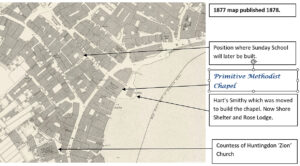
This profile for St Ives Primitive Methodist Chapel in Fore Street has been compiled by Val Thomas of St Ives Old Cornwall Society.
Down’long St Ives is primarily a fishing and trading port with safe harbour. There were numerous mines for tin and copper up’long.
St Ives Primitive Methodist Chapel is in the heart of Down’long and was built for the fishermen and mariners to use as their local chapel. It is Grade 2 listed.
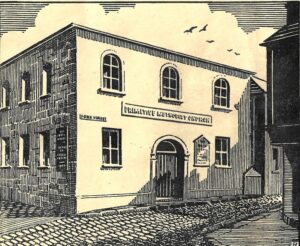 Front cover image from Cyril Noall History of Fore Street Methodist Chapel book.
Front cover image from Cyril Noall History of Fore Street Methodist Chapel book.
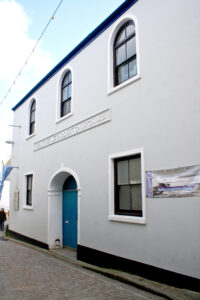 Alterations have been made over the years, but it remains in appearance substantially the same. (Photo: Jo Lewis)
Alterations have been made over the years, but it remains in appearance substantially the same. (Photo: Jo Lewis)
1743 Captain Joseph Turner, of Bristol put into St Ives where he was surprised to find a number of persons who regularly met together for worship, after the fashion of some Methodist Societies already established in other parts of the country. Thomas Williams and William Shepherd were then sent to Cornwall andbegan to preach in the town. In July of that year Charles Wesley set out from Bristol and arrived in St Ives on horseback. He was not warmly welcomed but retired to the house of John Nance which was behind the Wesleyan Methodist Chapel as we now know it, in Street an Garrow. John Wesley arrived later that year but again, was not warmly welcomed. John Wesley went on to visit the town for 40 years and converted a great many of the population.
1810 The Primitive Methodists Society had originally formed to allow laymen to preach in the chapels.
1812. The name ‘Primitive Methodists’ was formally adopted.
1829 A breakaway society known as the Primitive Methodist formed in the town o June 15th. Joseph Grieves preached in the town for the first time on a large (decked) boat near the quay; the most populous and wicked part of the town. The following week about 1,000 people assembled to listen and many wept. There were open air meetings for some months to large and attentive congregations. Prior to the Fore Street chapel being built there are records which show that Quick’s sail loft on the wharf was used as a meeting place. It is supposedly in this sail loft that the floor threatened to give way under the weight of worshippers so the meeting was continued in the cellar below.
1830 May 2nd A camp meeting was held in the open air when about 5,000 people were supposed to be present. It is supposed this meeting was held on the Island Wastrel, an area of open land below the Island.
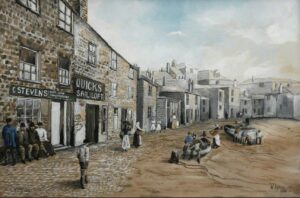 The Harbour Front, The Wharf, St Ives 1880. William Edwin Ayres Owned by St Ives Guildhall
The Harbour Front, The Wharf, St Ives 1880. William Edwin Ayres Owned by St Ives Guildhall
1831. The church was built by the harbour front of Blue Elvin (which is the local name for greenstone) ‘bowlies’ (sea rounded rocks) and granite. These were brought by fishing boat from Porthmeor Cove, near Gurnard’s head and carried to the site by women in their aprons. Tradition is that the wooden pillars which support the gallery were spare masts given by the skippers of the fishing luggers.
The land for the building was originally an orchard and a strip of foreshore opposite Bunker’s Hill. John Hart, an old St Ives blacksmith and founder member of the Society had his wooden smithy on this land but moved the whole building nearer the harbour to allow room for the chapel. To prepare the land Mr Hart prepared a rampart against the sea of old ships timbers set on end, around which he spread the ashes from his forge and so made a ‘plat’ which was known as ‘Hart’s Shop’. His ‘smithy’ is still there, now known as Shore Shelter and Rose Lodge. The original smithy needed replacing but as no rent had been paid and the land was not owned by the smithy, permission was not given. This was circumnavigated by building the new smithy, complete with slate roof, inside the old one and then demolishing the original. There are various stories about the ownership of the land on which the chapel and smithy were built, and whether or not they owned the land to the foreshore. A document dated Dec 30th 1830 shows a tract of land with a lease for 99 years with rent of £11 per annum being assigned to the trustees of the chapel “for the purpose of erecting and building a chapel or meeting house upon the site…” Sir John St Aubyn, Bart. of Clowance was an original owner of the land. The trustees names are given as: Thomas Carbines and James Semmens, miners; William Cogar, cordwainer; John Rowe, labourer; William Ninnis, fisherman; John Andrew, mariner; James Shugg, mason; James Woolcock, miner; James Thomas, sailor and Henry Care, fisherman all of St Ives. The land to the east of the chapel site is now known as Chy-an-Chy, but was then known as ‘Purfle’s Plot’ and was a general storage area.
Over the coming months many were saved and God’s power was felt strongly. Meetings were started indoors in sail lofts around the harbour.
The builder and master mason of the chapel is said to have been Mr Richard James. It is written as ‘a plain building, slightly longer than wide, with a gallery running nearly all the way round’. The oppressive looking gallery and the rather uncomfortable high backed seats are still there but now painted a light blue. The building will seat 8oo people. The main entrance is in Fore Street and it has a vestibule within with a panelled ceiling. However, there were alternative doors in the side, one of which has now been blocked up. There are two staircases to the gallery which originally had hand rails but are now partitioned. The original windows were brightly coloured and had stars cut in them to form a decorative pattern. These have now been replaced. There are, in 2024, some simple stained glass windows on the seafront elevation.
Music was originally provided by a group of minstrels, consisting of violins, ‘cellos, clarinet etc and a special platform was provided for them and the choir’. These instrumentalists took the place of a ‘striker’ of tunes who led the singing in some other chapels in St Ives. A pipe organ was later installed. The choir sits above the pulpit with the organ behind. The staircase, which leads from the choir to the vestry, and the pulpit were made by Mr Tom Burrell. There have been a few minor alterations to the original arrangement over the years. There used to be seat under the pulpit for the use of the twelve ‘leaders’.
Lighting It is not known how the chapel was originally illuminated but there is a silvered glass ball, about 2 feet in diameter, which was used in the centre of a candelabra to reflect the light when the place was lit by candles or oil. Gas was then installed with upright gas-mantles enclosed in semi opaque shades shaped like milk bottles. The electric light system was installed by Mr J. T. Barber (of Mission Minstrel fame).
In its early days the chapel was known as the “Ebenezer”.
Cost The total cost of the building was £830 1s 1d and, when completed, the debt was £680 which was covered by a mortgage.
1832 There is no recorded opening of the chapel but records show cholera was raging in neighbouring owns at the time. Services were held there in September 1832.
1835 The first of the country Primitive Methodist chapels was built at Trevalgan. The lease for the land is dated 1835.
1838 The Teetotal movement spread to the town which affected membership of the chapel.
1841 December, Mr John Andrews headed the Ebenezer Teetotal Society.
1844 Baptismal records are held in Somerset House from this date.
1851 The census return shows 300 free seats and 500 open, which makes a total of 800 seats.

1855 Building started on a chapel in Towednack at the top of the hill on the main road leading from Nancledra to Penzance. This was another Primitive chapel.
1859 June 1st The Foundation stone of a new Primitive Methodist chapel at Lelant were laid by Capt. Peter Bryant of St Ives.
1862 Balnoon chapel was opened by the St Ives Primitive Methodist Society. This chapel closed in 1888 due to the decline in mining.
Another chapel was started in Lady Downs. There were also small meeting houses at Chyangweal, near Trencrom, Lelant Downs and Wheal Reeth.
Camp meetings were conducted at various places within the borough. On May 19th 1889 the minister, Rev T. Sadler and Mr Nairn, a Scottish evangelist then working here, “marched through the town singing hymns” on their way to a camp meeting on the Island. Another gathering took place on The Island in the afternoon.
Sunday School Tea Treat was another outdoor occasion. Children dressed in their finest holiday attire and decked with roses, used to assemble at their chapel, and then, headed by a brass band, would perambulate through the town to an open space somewhere in the neighbourhood – Borallen (Burthallan Lane area), The Belyars Bull Field or Carthew, and there, after large saffron buns and tea, indulged in games and pastimes. The procession of children sometimes numbered 500 with their brightly coloured banners.
Silken Banners: A feature of these open-air processions were the silken banners. The oldest banners have long since gone but one is still in existence which reads “Primitive Ebenezer Sabbath School” and was designed by Jim Pearce and embroidered by the women of the school, the material itself having been
supplied by the old Crysede Silk Factory which was on the the Island. A pale blue banner was the gift of Mrs Trevorrow while the newest one was made and given by the wives of members of the Men’s Bible class.
1851 Joseph Grieves revisited after a gap of 18 years and was enthusiastically welcomed by members.
1861 Sunday 27th October was a high day for the start of a revival brought about by the arrival of Rev. William Booth. 74 conversions took place in one week during November!
1882 April 15th The Cornishman. The chapel has recently undergone a through rewiring, the work being entrusted to William Trevorrow.
1890 January. 270 people sat down to tea. There were a large number of young people in the Church and Sunday School.
1892 The chapel advertised as holding noon-day prayer meetings each day of the week from 12 to 1 o’clock commencing Monday 2nd January. Sankey’s Hymns were used.
1893 New Year’s tea and meeting was most successful. Three Hundred partook of tea and in the evening there was a largely attended public meeting. This was the first effort to liquidate the £3600 debt on the chapel.
1893 Feb/March The Primitive Methodist Chapel was crowded, even the aisles and vestibule being filled. The occasion was that of a miscellaneous entertainment by members of the band of Hope and Temperance Society.
1894 St Ives Weekly Summary and visitors list January 20th. Plans were submitted by Mr Toy for an addition to the Methodist Chapel to be built on the foreshore. The council declined approval. Reconsideration was applied for by Rev James Crompton who pointed out that certain stones, called fenders, at the front of the Chapel had been buried by the raising of the street. In their absence the Chapel walls are being damaged by passing conveyances. The Chapel title-deeds convey all land down to high-water mark; that on that land the Chapel had, for 30 years boiled water for tea-meetings etc.
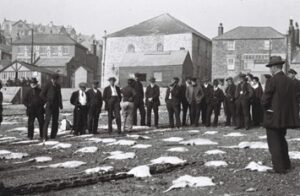 The chapel in the harbour showing the blacksmith’s shop in front. Many of these men would have been members of the chapel. Image: Brian and Margaret Stevens
The chapel in the harbour showing the blacksmith’s shop in front. Many of these men would have been members of the chapel. Image: Brian and Margaret Stevens
1894 January 18th The Cornishman newspaper. The organ had been reconstructed by Mr Murgatroyd, of Bradford. It was formally opened on Saturday evening in the presence of a crowded congregation. The Lelant Wesleyan and St Ives Primitive Methodist Choirs took part.
1895 Supplement to the St Ives Weekly Summary July 13th:
“St Ives Primitive Methodist Chapel. – Last Saturday evening, the trustees of the above place of worship held a meeting, when the new deed was exhibited, the freehold having been recently purchased from Lord St Levan. The friends expressed their gratification at the manner in which the Rev. J. Crompton (the superintendant minister) had done his business, as well as their pleasure with the financial statement.”
1895 The Primitive Methodists celebrated their 64th anniversary in November.
1900 July St Ives Weekly Summary. “The choir, with their organist and friends had their annual outing on Tuesday last. Starting at the Board Schools at about 7am, the party journeyed to the Gurnard’s Head, and after making a short stay there, Proceeded to St Just and Cape Cornwall. At the latter place the “cravings of the inner man” were attended to. The choir rambled about the Headland for over two hours, enjoying the splendid scenery at this charming little spot, and then left for Sennen Cove, and after inspecting that quaint village, proceeded across the rugged cliffs to Lands End, where the eye never tires looking at the grand and beautiful scenery to be found there, and watching the scores of steamships and sailing vessels passing inside and outside the Longships. Newlyn and Penzance were next visited, and a drive home at night in the lovely moonlight bright a most enjoyable day’s outing to a close. The brake and jersey car were supplied by Mr Samuel Michell, North-terrace.”
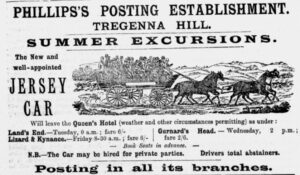 This advert was in the same newspaper.
This advert was in the same newspaper.
1901 From the St Ives Weekly Summary June 1900. Primitive Methodist Festival.
“Yet another jollification; Delightful weather favoured the annual festival of the Primitive Methodist Sunday School on Tuesday, when there was a splendid muster of children and teachers. The procession was of considerable length and was bright with banners, bannerettes and flags. Several of the fishing boats also hoisted ‘colours’ in honour of the occasion. The music was again supplied by the St Ives and Towednack Bands. Tea was partaken of in a field at Ayr, kindly lent by Messers Berriman. After the ‘inner man’ had been refreshed, the teachers and scholars joined in several games, and the outing for 1,900 was most enjoyable.”
Yes, 1,900 was the number of people quoted as being present!
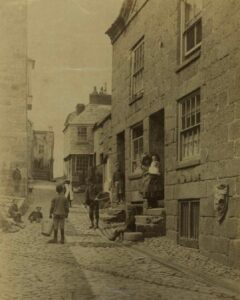 Bunkers Hill, formerly Bolton Street. The building on the far top left was the Brooking Williams Seine Company cellar which was replaced by the Fore Street (Primitive Methodist) Chapel Sunday School in 1922. Image: Penlee House Gallery and Museum
Bunkers Hill, formerly Bolton Street. The building on the far top left was the Brooking Williams Seine Company cellar which was replaced by the Fore Street (Primitive Methodist) Chapel Sunday School in 1922. Image: Penlee House Gallery and Museum
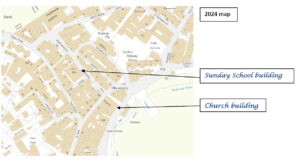
1904 Work started on collecting money for this building. The foundation stones were laid in the presence of the mayor, Alderman W. Pearce and the superintendant minister, the Revd R. Ruttter and other guests in 1922. The memorial stones commemorate the many stalwarts who supported the church. The building, designed by Mr Wills, was opened a year later.
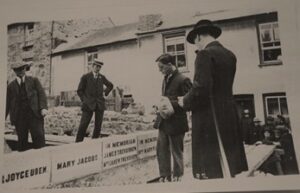 Laying the memorial stones for the Sunday school building on Rose Lane/ Bunkers Hill.
Laying the memorial stones for the Sunday school building on Rose Lane/ Bunkers Hill.
Rev. Philip Slater wrote: On Saturday August 26th 1922 the ceremony of laying a number of Foundation and in Memoriam stones was performed on the site of the new school. A large and representative gathering present for the occasion included the mayor (Ald. J. Daniel. The Rev. R. M. T. 34 Rutter (Superintendent Minister) to whose energetic labours the scheme’s success was largely due …etc. Rev. Rutter in the black coat. Image: William Thomas
1905 Those present at the opening included the mayor and mayoress (Mr and Mrs Beckerleg), the Revd and Mrs Rutter, Mr James Ninnis, ‘Father’ Freeman, Mr R. Tanner, Miss K. French, magistrates, aldermen and councillors, Free Church ministers, members of the business and fishing communities and a large crowd of members who filled the little street.
1909 St Ives Weekly Summary, Feb 6 Prize distribution. St Ives Primitive Methodist Sunday-school children had their prizes distributed to them by their pastor, Rev. A. Johnson, on Sunday afternoon. The school is a large one, 300 scholars and teachers being on the books.1925 March An Infant Welfare Centre for the Borough was started in the primary room.
1941 February Costan’s Junior School, Middlesex. Children from this school were evacuated to St Ives and accommodated in the Primitive Methodist Sunday School. The children were apparently ‘perfectly at home’ in their new surroundings.
1953 Love Feasts The chapel revived a special service known as ‘Love Feast’. The practice was to sip water from a special kind of china cup while biscuits were carried around. Speeches would be made and hymns sung. Three very old Love Feast Cups bearing the date “June 15th 1829” are still preserved in the chapel in a glass case. There were originally four of these cups but one was loaned to Trewint Wesley Museum.
Chapel Teas were held at the Ebenezer quite frequently. The water used to be boiled in the urns on Wharf Road at the rear of the building. This practice went back to the building of the chapel in 1931. The original deed of the site gave the chapel possession of the foreshore on this side. This practice is no longer carried out due to traffic.
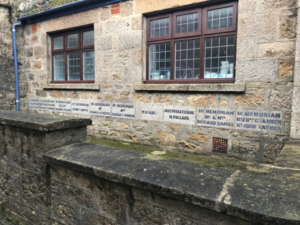
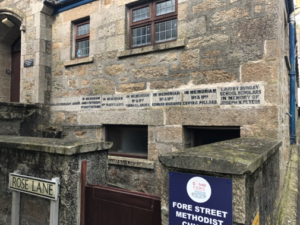

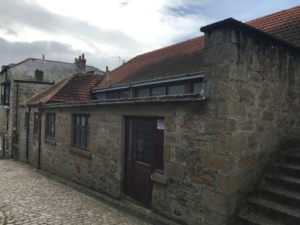
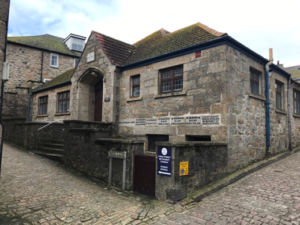 The Sunday School building 2024. images: Val Thomas
The Sunday School building 2024. images: Val Thomas
 Church Logo
Church Logo
2024 The Church and Sunday school are still open for worship: the last remaining large place of worship in St Ives.
Mr. W. H. Y. Titcomb and the Primitive Methodist Chapel, St Ives. The chapel have these charcoal sketches.
 Excerpts from Mary Quick’s article produced by the St Ives Archive.
Excerpts from Mary Quick’s article produced by the St Ives Archive.
The Chapel is in possession of three large charcoal drawings, which hang on its walls, from which Mr Titcomb subsequently painted these pictures. They were painted towards the end of the 19th century.
Many of the ‘character’ parts were taken by members of the congregation at that time.
It is Mrs Rouncefield who is lying in bed, and the woman weeping beside her is her daughter Catherine who later became Mrs Hart. The man standing in prayer was Mr. John B. Stevens, owner of the fishing vessel Amelia. In 1934 the Amelia was run down by a French steamer and Barnabus and Fred Stevens and James Penberthy were lost.
The figure leaning across the bed was Mr George Quick, a local preacher better known as ‘Georgie Crutch’, from the crutch which his lameness obliged him to use.
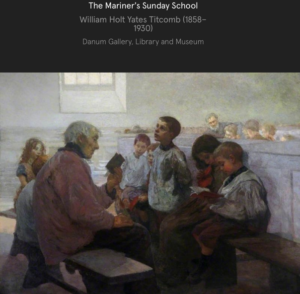 A Sunday School class is in progress and one of the young boys is being questioned by his teacher, an old fisherman.
A Sunday School class is in progress and one of the young boys is being questioned by his teacher, an old fisherman.
The charcoal drawing in the chapel and this painting are different in that the girl is looking at a crab in the boys hand in the drawing. The person in the right background is said to have been a well known local character called ‘Prussian Bill’. He came to St Ives originally as a cabin boy on a German sailing ship carrying smuggled goods. While the captain, a man called ‘Worm’ and his crew were ashore disposing of contraband, Customs Officers came aboard the vessel and he pretended to speak to no English. He repeated this performance at a later trial which led to him being called ‘Old Worm’s Fool. His real name was Schmidt or Smith and he later became a baker.
The teacher is Mr Tom Bassett. One of the boys was portrayed by Samuel Hart born in 1884 and later founder and proprietor of Hart’s Ice Cream parlour. Mr Thomas Quick, Mr Reggie Stevens, Mr Tommy Peak and Mr Kurt are also in it. Also, Dan Veal, Nat Oliver, Tommy Quick and Nancy Veal.
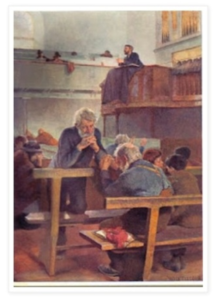 This March 1889 painting depicts Methodists in prayer within the chapel itself. The artist has accurately produced not only the chapel complete with gallery and high-backed forms, but also the earnest and devout reverence of the worshippers.
This March 1889 painting depicts Methodists in prayer within the chapel itself. The artist has accurately produced not only the chapel complete with gallery and high-backed forms, but also the earnest and devout reverence of the worshippers.
Mary Quick writes that the preacher was represented by Mr Louis Grier, a well known St Ives artist at the time. Capt. Dick Harry aged 86 is the man with his chin in his hands. He was one of the oldest and most consistent member of the Primitive Methodist chapel who was in other Titcomb paintings. Mr Job Stevens and Mr Wedge, a member of the family owning the fishing vessel ‘Vivid’ are also in it.
It is thought that this was a weeknight service. The younger men are at sea and the older men in their workday, well worn clothes have turned in at the little Bethel as they loved to do as often as possible during the weekdays.
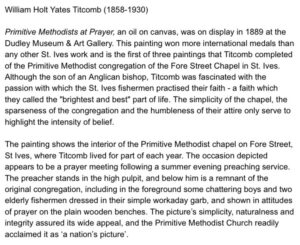
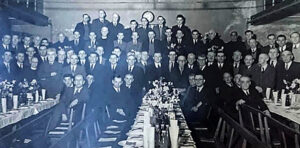 Inside the Sunday School building. Matthew Thomas in the centre. No date. Image: Emma Scott
Inside the Sunday School building. Matthew Thomas in the centre. No date. Image: Emma Scott
Kresen Kernow resources
MRI/156 Resources date 13th Dec 1874 Sunday school anniversary
Other Resources
St Ives Then and Now – St Ives Archive.
History of the St Ives Fore Street Methodist Church (formerly Primitive Methodist) – edited by Cyril Noall Produced by the Trustees of the Chapel
Find My Past newspaper reports
William Thomas
Mary Quick books produced by St Ives archive.
Internet searches

Did one William Alexander BLACKETT ever come to these Cornish churches? He ended up as a Bush Missionary in Tasmania, Australia. He was my second great grandfather and I think he had some connection to sailing around the world. I would love to hear if anyone knows of him!